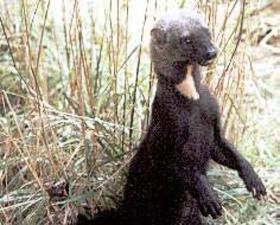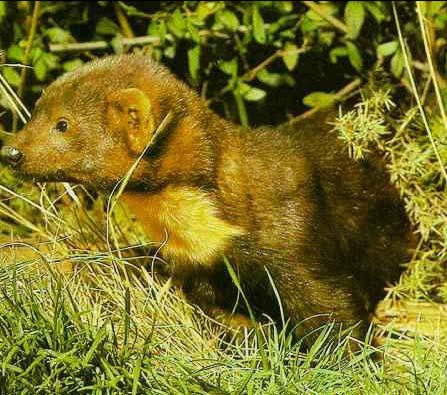
|
 The Tayra

 The tayra (Eira barbara) is a
member of the weasel family
(Mustelidae), which also includes
otters, skunks and minks. It is the only
species in the genus Eira. The tayra,
also spelled “tiara”, is sometimes
called “swamp or bush dog” and its
Creole name is Haka. Tayras can be
found in the neo-tropical forests of
Central and South America, and
ranges from Mexico, south to Bolivia
and northern Argentina and also on
the island of Trinidad. In these areas
they live in tropical, deciduous and
evergreen forests, secondary growth,
fields and plantations. The elevation
of their habitat ranges from the lowlands
to about 2000 to 2400 m. Because
the tayra is both terrestrial and
arboreal, it has been found to live in
hollow trees, burrows built by other
animals and occasionally in tall
grass. Despite their wide occurrence
and relatively large size, surprisingly
little is known about tayra reproduction,
life span, home ranges or habits.
This large, long-legged weasellike
animal is the size of a medium
sized dog, with a long, bushy tail and
long neck ending in a robust head.
The tayra (Eira barbara) is a
member of the weasel family
(Mustelidae), which also includes
otters, skunks and minks. It is the only
species in the genus Eira. The tayra,
also spelled “tiara”, is sometimes
called “swamp or bush dog” and its
Creole name is Haka. Tayras can be
found in the neo-tropical forests of
Central and South America, and
ranges from Mexico, south to Bolivia
and northern Argentina and also on
the island of Trinidad. In these areas
they live in tropical, deciduous and
evergreen forests, secondary growth,
fields and plantations. The elevation
of their habitat ranges from the lowlands
to about 2000 to 2400 m. Because
the tayra is both terrestrial and
arboreal, it has been found to live in
hollow trees, burrows built by other
animals and occasionally in tall
grass. Despite their wide occurrence
and relatively large size, surprisingly
little is known about tayra reproduction,
life span, home ranges or habits.
This large, long-legged weasellike
animal is the size of a medium
sized dog, with a long, bushy tail and
long neck ending in a robust head.

Tayras can be seen moving rapidly
through the trees or on the ground. Both
terrestrial and arboreal, they are very
fast runners and despite their limited
eyesight are skilled climbers as well.
They have been reported to climb down
smooth tree trunks from heights of
greater than 40 meters. |
Its
head and body range from 600 to 700
mm in length and its tail length is 350
to 450 mm. Tayras have large hind
feet varying in length from 80 to 90
mm with round, short ears that are about 35 to 40 mm long.
Color varies with geographic range, but in general the tayra’s
dark skin is covered by dense, short fur that is brown in color
with a slightly paler head. The fur on its head changes to brown
or gray as it ages. Usually it has a white, diamond shaped patch
on its throat and chest. Tayras have long claws, pronounced
canines and weigh 4 to 5 kg.

Despite their wide occurrence and relatively
large size, surprisingly little is
known about tayra reproduction, life
span, home ranges or habits. Being
small and secretive, Mustelids, among
other groups of small carnivores, are
often neglected by conservation programs
which are usually aimed at
larger, more charismatic species. |
They are a diurnal species that are sometimes active at dusk
or before dawn. Tayras usually travel alone or in pairs, however,
they are occasionally seen in small groups of 3 to 4 individuals,
the sexual distribution of which is unknown. In their
forest habitats, tayras often appear inquisitive, moving their
heads in an undulating, snakelike fashion to determine scents or
sights. They can be seen moving rapidly through the trees or on
the ground. Both terrestrial and arboreal, tayras are very fast
runners and despite their limited eyesight are skilled climbers
as well. They have been reported to climb down smooth tree
trunks from heights of greater than 40 meters. Terrestrial locomotion
is usually composed of erratic, bouncing movements with
the back arched and the tail along the ground. Arboreal movements
along horizontal branches are more fluid, and the tail is
used as a balancing rod. A tayra may leap for considerable
distances, run up rocky cliffs, and bound from branch to branch
in the trees. It is usually silent, but when alarmed, the tayra
gives a short, barking call and may snort, growl,
and spit while seeking protection in a nearby tree.
They have been known to give yowls, snarls or
clicks when in groups.
Although classified as carnivores, tayras are
omnivorous, with diets comparable to those of raccoons.
It shows a preference for small mammals,
the spiny rat in particular, but it will eat whatever
is available, such as guinea pigs, mice, squirrels,
agoutis and poultry. The tayra will also eat significant
amounts of fruit, invertebrates and reptiles.
It has also been shown that they will occasionally
eat honeycomb when it is available.

The tayra is a large, long-legged weasel-like animal that is the size of a
medium sized dog, with a long, bushy tail and long neck ending in a robust
head. Color varies with geographic range, but in general the tayra’s dark
skin is covered by dense, short fur that is brown in color with a slightly
paler head. Usually it has a white, diamond shaped patch on its throat and
chest. |
Little is known about the tayra’s reproduction.
However it is thought that gestation lasts for about
63 to 70 days with a litter size of 2 to 3 babies per
season, each weighing about 74 to 92 grams. Newborns
open their eyes in about 5 to 8 days and they
nurse for 2 to 3 months. Some believe that the mating
cycle is seasonal, with births occurring in
March and July. Others believe that the tayra has
monthly mating periods and is a non-seasonal
breeder.
Being small and secretive, Mustelids, among
other groups of small carnivores, are often neglected
by conservation programs which are usually
aimed at larger, more charismatic species.
 Help is needed and you could make a difference by contributing to the conservation
of small carnivores, through the International Union for the Conservation
of Nature and Natural Resources (IUCN) World Conservation
Union Small Carnivore Specialist Group. If you are interested in becoming
a member of the Specialist Group or would like more information please
visit their website the IUCN website at http://iucn.org
Help is needed and you could make a difference by contributing to the conservation
of small carnivores, through the International Union for the Conservation
of Nature and Natural Resources (IUCN) World Conservation
Union Small Carnivore Specialist Group. If you are interested in becoming
a member of the Specialist Group or would like more information please
visit their website the IUCN website at http://iucn.org
Click here to return to the main page for Caribbean Critters
|


 The tayra (Eira barbara) is a
member of the weasel family
(Mustelidae), which also includes
otters, skunks and minks. It is the only
species in the genus Eira. The tayra,
also spelled “tiara”, is sometimes
called “swamp or bush dog” and its
Creole name is Haka. Tayras can be
found in the neo-tropical forests of
Central and South America, and
ranges from Mexico, south to Bolivia
and northern Argentina and also on
the island of Trinidad. In these areas
they live in tropical, deciduous and
evergreen forests, secondary growth,
fields and plantations. The elevation
of their habitat ranges from the lowlands
to about 2000 to 2400 m. Because
the tayra is both terrestrial and
arboreal, it has been found to live in
hollow trees, burrows built by other
animals and occasionally in tall
grass. Despite their wide occurrence
and relatively large size, surprisingly
little is known about tayra reproduction,
life span, home ranges or habits.
This large, long-legged weasellike
animal is the size of a medium
sized dog, with a long, bushy tail and
long neck ending in a robust head.
The tayra (Eira barbara) is a
member of the weasel family
(Mustelidae), which also includes
otters, skunks and minks. It is the only
species in the genus Eira. The tayra,
also spelled “tiara”, is sometimes
called “swamp or bush dog” and its
Creole name is Haka. Tayras can be
found in the neo-tropical forests of
Central and South America, and
ranges from Mexico, south to Bolivia
and northern Argentina and also on
the island of Trinidad. In these areas
they live in tropical, deciduous and
evergreen forests, secondary growth,
fields and plantations. The elevation
of their habitat ranges from the lowlands
to about 2000 to 2400 m. Because
the tayra is both terrestrial and
arboreal, it has been found to live in
hollow trees, burrows built by other
animals and occasionally in tall
grass. Despite their wide occurrence
and relatively large size, surprisingly
little is known about tayra reproduction,
life span, home ranges or habits.
This large, long-legged weasellike
animal is the size of a medium
sized dog, with a long, bushy tail and
long neck ending in a robust head.




